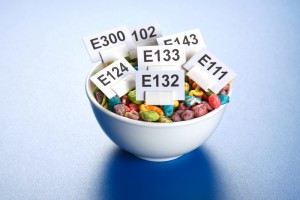 As Queensland’s Additive Alert Community Talks Presenter I teach people key lessons from the Australian Best Seller Additive Alert: Your Guide to Safer Shopping. This list from Additive Alert includes SOME of the worst additives that most people want to avoid as they are linked to adverse health problems. If you have asthma or specific health concerns, or if you have young children there are other additives you might need to avoid!
As Queensland’s Additive Alert Community Talks Presenter I teach people key lessons from the Australian Best Seller Additive Alert: Your Guide to Safer Shopping. This list from Additive Alert includes SOME of the worst additives that most people want to avoid as they are linked to adverse health problems. If you have asthma or specific health concerns, or if you have young children there are other additives you might need to avoid!
Colours: 102 (Tartrazine), 104 (Quinoline Yellow), 110 (Sunset Yellow FCF), 122 (Azorubine or Carmosine), 123 (Amaranth), 124 (Ponceau 4R), 127 (Erythrosine), 129 (Allura Red AC), 132 (Indigotine), 133 (Brilliant Blue), 142 (Green S), 151 (Brilliant Black), 153 (Carbon Black), 155 (Brown HT), 160b (Annatto), 173 (Aluminium), 174 (Silver), 175 (Gold)
Preservatives: 211 (Sodium Benzoate), 212 (Potassium Benzoate), 213 (Calcium Benzoate), 216 (Propylparaben), 218 (Methylparaben), 249 (Potassium Nitrite), 250 (Sodium Nitrite), 251 (Sodium Nitrate), 280 (Propionic Acid), 281 (Sodium Propionate), 282 (Calcium Proprionate)
Antioxidants: 310 (Proply gallate), 311 (Octyl gallate), 312 (Dodecyl gallate), 319 (Tert-Butylhydroquinone TBHQ), 320 (Butylated hydroxyanisole BHA), 321 (Butylated hydroxytoluene BHT)
Gums: 407 (Carrageenan), 407A Processed eucheuma seaweed), 466 (Sodium carboxymethylcellulose)
Flavour enhancer: 621 (Monosodium L-glutamate MSG), 627 (Disodium 5\-guanylate), 631 (Disodium 5\’- inosinate), 635 (Disodium 5\’- ribonucleotides), 637 (Ethyl maltol)
Others: 900 (Polydimethylsiloxane), 914 (oxidized polyethylene), 943 (a-butane, b-isobutane), 944 (propane), 950 (Acesulphame potassium), 951 (Aspartame), 952 (Calcium cyclamate, sodium cyclamate), 954 (saccharin or calcium/sodium/potassium saccharin), 955 (sucralose), 1201 (polyvinylpyrrolidone), 1520 (Propylene glycol), 1521 (polyethylene glycol 8000).
In the back of the book Additive Alert: Your Guide to Safer Shopping you will be able to use the tables in Appendix 1 to work out which additives you need to avoid for specific health/ behaviour issues.
You can grab a copy of Additive Alert by clicking here.
To review the scientific journals and references please refer to pages 138-144 in Additive Alert, however a snapshot of articles and references available online can be found below.
Dengate, Sue; Fed Up; Random House Australia 1998
Online Resources: Fed Up: http://fedup.com.au/information/information/scientific-references#byadditive
Butyladed Hydroxyanisole (BHA) CAS No. 25013-16-5; Reasonably Anticipated to be a Carcinogen; Ninth Report on Carcinogens
Dingle Peter; 2600 Food Additive Course Notes; July 2003
J Breaky; Review Article – The role of diet and behaviour in childhood; Journal of Paediatrics and Child Health 1997; 33 (3): 190-4
Lau K et al, Synergistic interactions between commonly used food additives in a developmental neurotoxicity test – Toxicol Sci 2005: Dec 13 http://toxsci.oxfordjournals.org/cgi/reprint/90/1/178.
McCann D et al, Food additives and hyperactive behaviour in 3-year-old and 8/9-year-old children in the community: a randomised, double-blinded, placebo-controlled trial. Lancet. 2007;370(9598):1560-7.
Pelsser LM et al Effects of a restricted elimination diet on the behaviour of children with attention-deficit hyperactivity disorder (INCA study): a randomised controlled trial. Lancet. 2011;377(9764):494-503. http://www.ncbi.nlm.nih.gov/pubmed/21296237
Swain A, Soutter V, Loblay R, Truswell AS. Salicylates, oligoantigenic diets, and behaviour. Lancet 1985;2(8445):41-2.
Food additives affect concentration: twin study. The Daily Telegraph, 1/5/2003, page A14. http://www.telegraph.co.uk/news/uknews/1428657/Twin-outshines-brother-on-additive-free-diet.html
Clarke L etal. The dietary management of food allergy and food intolerance in children and adults. Aust J Nutr Diet 1996;53(3):89-94.
Schoenthaler SJ etal. The impact of a low food additive and sucrose diet on academic performance in 803 New York City public schools. International Journal of Biosocial Research, 1986 (8)2:185-195.
Dr Ben Feingold. Why your child is hyperactive. Random House, New York, 1974 and Feingold BF.
Hyperkinesis and learning disabilities linked to the ingestion of artificial food colours and flavours. J Learn Disabil. 1976;9(9):19-27.
Wolraich and others, Effects of diets high in sucrose or aspartame on the behavioural and cognitive performances of children. New Eng J Med 1994;330(5):301-7.
Allen DH and others. Adverse reactions to foods. Med J Aust. 1984;141(5 Suppl):S37-42.
Anne Swain, Velencia Soutter, Robert Loblay, RPAH Elimination Diet Handbook with food & shopping guide. Allergy Unit, Royal Prince Alfred Hospital, 2009 and Swain AR, Soutter VL, RH L. Friendly Food. Sydney: Murdoch Books, 2002. www.allergy.net.au
Rowe KS, Rowe KL. Synthetic food colouring and behaviour: a dose response effect in a double-blind, placebo-controlled, repeated-measures study. J Pediatr 1994;125:691-8.
Samuels A. The toxicity/safety of processed free glutamic acid (MSG): a study in suppression of information. Accountability of Research. 1999;6(4):259-310. http://www.truthinlabeling.org/l-manuscript.html
Fifty-first meeting of the Joint FAO/WHO Expert Committee on Food Additives. Safety Evaluation of Certain Food Additives: sulfur dioxide and sulfites; evaluation of national assessments of intake of benzoates; evaluation of national assessments of intake of butylated hydroxyanisole (BHA); evaluation of national assessments of intake of butylated hydroxytoluene. Geneva: World Health Organisation, 1999.
Towns SJ, Mellis CM. Role of acetyl salicylic acid and sodium metabisulfite in chronic childhood asthma. Pediatrics 1984;73(5):631-7.
Freedman BJ. Asthma induced by sulphur dioxide, benzoate and tartrazine contained in orange drinks. Clin Allergy 1977;7(5):407-15.
Hodge L, Yan KY, Loblay RL. Assessment of food chemical intolerance in adult asthmatic subjects. Thorax 1996;51(8):805-9.
Jenkins C, Costello J, Hodge L. Systematic review of prevalence of aspirin induced asthma and its implications for clinical practice. Brit Med J 2004;328(7437):434.
Allen DH, Delohery J, Baker G. Monosodium L-glutamate-induced asthma. J Allergy Clin Immunol 1987;80(4):530-7.
Rowe KS, Rowe KJ. Synthetic food coloring and behavior: a dose response effect in a double-blind, placebo-controlled, repeated-measures study. J Pediatr 1994;125(5 Pt 1):691-8.
Swain A, Soutter V, Loblay R, Truswell AS. Salicylates, oligoantigenic diets, and behaviour. Lancet 1985;2(8445):41-2.
http://www.lancet.com/journals/lancet/article/PIIS0140-6736%2810%2962227-1/abstract
Breakey J et al. A report on a trial of the low additive, low salicylate diet in the treatment of behaviour and learning problems in children. Aust J Nutr Diet. 1991;48:89-94.
Bennett CPW, McEwen LM, Rose E. The Shipley Project. J Nutr Envir Med 1998;8(8):77-83.
Parker G, Watkins T. Treatment-resistant depression: when antidepressant drug intolerance may indicate food intolerance. Aust N Z J Psychiatry 2002;36(2):263-5.
Hyman SL and others, Dietary Treatment of Young Children with Autism: Behavioral Effects of the Gluten Free and Casein Free Diet. Presented at the International Meeting for Autism Research, Philadelphia, May 22, 2010. http://www.urmc.rochester.edu/news/story/index.cfm?id=2860
McFabe DF et al. Neurobiological effects of intraventricular propionic acid in rats: possible role of short chain fatty acids on the pathogenesis and characteristics of autism spectrum disorders. Behav Brain Res. 2007 Jan 10;176(1):149-69.
Slimak, K. 2003. Reduction of autistic traits following dietary intervention and elimination of exposure to environmental substances. In Proceedings of 2003 International Symposium on Indoor Air Quality and Health Hazards, National Institute of Environmental Health Science, USA, and Architectural Institute of Japan, January 8-11, 2003, Tokyo, Japan, vol 2, pp 206-216.http://www.immuneweb.org/articles/slimak.html
Kobylewski S, Jacobson MF. Food Dyes: A Rainbow of Risks. Centre for Science in the Public Interest. 2010 http://www.cspinet.org/new/201006291.html
Jacobson MF, Schardt MS. Diet, ADHD and behaviour: a quarter-century review. Washington DC: Centre for Science in the Public Interest, 1999. http://www.cspinet.org/new/pdf/dyesreschbk.pdf
“May have an adverse effect on activity and attention in children” must be used on foods in the EU. http://eur-lex.europa.eu/LexUriServ/LexUriServ.do?uri=OJ:L:2008:354:0016:0033:en:PDF
Dengate S, Ruben A. Controlled trial of cumulative behavioural effects of a common bread preservative. J Paediatr Child Health 2002;38(4):373-6.
Brusque AM, Mello CF, Buchanan DN et al. Effect of chemically induced propionic acidemia on neurobehavioral development of rats. Pharmacol. Biochem. Behav. 1999;64(3):529-34.
MSG without numbers, from a glutamate industry website: http://internal.ific.org/publications/brochures/msgbroch.cfm
Glutamates in Foods from Nicholas and Jones (1991) and Yoshida (1998) in FSANZ report http://www.foodstandards.gov.au/_srcfiles/MSG%20Technical%20Report.pdf











Hi,
You say that these have been linked to health issues, could you please provide some links and references to the research that confirms this.
Thanks
Hi Andrew
The references are in the back of the book Additive Alert, however I have included a few extras too. Hope this helps.
Kindest regards
Louise
I think your scaremongering would be more effective if you included citations for these “links to adverse health problems”. Good luck.
Hi Michael
thanks for your comment. I’ve noted the references – they are primarily in the back of the book Additive Alert, but I have included a few extras too. Hope this helps.
Kindest regards
Louise
Comments on this entry are closed.
{ 3 trackbacks }